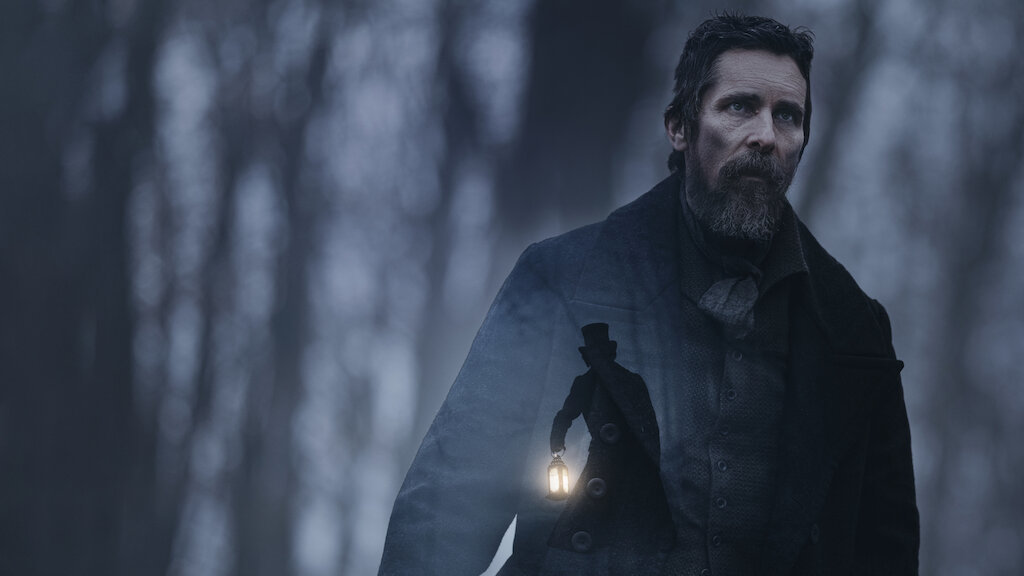
The Pale Blue Eye
Eerily atmospheric, though predictable.
Known for his multi-genre body of work, that includes the 2013 crime epic Out of the Furnace, the 2017 modern Western Hostiles, and the melancholic music motion picture Crazy Heart (2009), Scott Cooper returns for a novel adaptation, more specifically that of Louis Bayard's 2006 novel The Pale Blue Eye, a gothic crime/mystery set in the early 19th century in upstate New York. What makes Cooper's film to stand out is the fact that one of the two protagonists is a legendary figure in American literature and poetry, the author who in his 1841 short story titled The Murders in the Rue Morgue defined the principles of the detective fiction genre as we came to know it today, the master of the macabre, Edgar Alan Poe. Picking up the mantle from Christopher Hatton's -uneven- Raven's Hollow (2022), Cooper is both the director and the man who adapted Bayard's novel into a screenplay, thus making the movie a purely personal business. Christian Bale plays Augustus Landor, a semi-retired sleuth who is severely traumatized over the loss of both his wife, who died some years earlier, and his daughter, who left home and abandoned him forever, while Harry Melling, mostly known to the audience through his involvement in several movies of the infamous Harry Potter saga, incarnates Poe's character and delivers a performance that will become the subject of many future conversations among the cinephiles.
The story is set, chronologically, in 1830 and the West Point military academy is the locational axis around which the film's plot unfurls. The orderly life of the cadets will be upended when one of their own, a cadet named Fry, is found hanged in the woods with his heart torn out of his body. Acutely alarmed, the academy's top brass reach out for Landor whose reputation as a puzzle-solver exceeds his notoriety as a boozer, and assign him the case. Early in the course of the investigation, Landor is approached by a soft-spoken, elflike cadet named Edgar Alan Poe who instantly points out that the killer has to be a "poet" as the taking of the victim's heart can be nothing else than highly symbolic. At this point I will cite a passage from an interesting article (you can find it here) on symbolism as it exists in Poe's classic mystery story The Tell Tale Heart: "The heart represents all horrors of murder more vibrantly. Any study guide will agree that while an eye literally controls a narrator, those heart beats represent that all crimes can haunt people". Landor and Poe will continue working on the case together, discussing the new evidence that crops up, speculating and pondering regarding the identity of the villain. They both share an interest in the academy's doctor Daniel Marquis (Toby Jones) and his family, consisting of his wife Mrs. Julia Marquis (Gillian Anderson), daughter Lea (Lucy Boynton), and son cadet Artemus Marquis. The odd pair of investigators will get critical help by Jean Pepe (Robert Duvall), an expert on religious occults and demonic worship.
As the circle of possible suspects is very limited, it is not tough to guess right as far as to who the culprit is, though the why is a wholly different matter. However, despite being a purebred gothic crime tale, The Pale Blue Eye is not so much a plot-oriented movie. It is mainly about the two main characters and their evolving relationship while the consequences of their farewell discussion that we witness in the film's denouement are left to the audience's imagination. Poe, who did in fact enter the military academy in 1830, is the director's focus and the character's outlining is realized wonderfully by Melling's outstanding performance,. Observe his use of body language and the employment of all means of expression at his disposal in order to imbue nuanced colors to his interpretation of a mythical historical figure. Owen Gleiberman writes in his "Variety" Magazine review of the film (you can read it here) writes about the fictionalization of Poe's character and his portrayal on screen through the fruitful collaboration between director and actor: "He's small, with a square pale face framed by severely parted hair and eyes so burning with intelligence that they look a little crossed (...) he's a geek who styles himself as an aesthete-aristocrat, and he establishes his credentials as an early-American crime profiler".
Poe proves to be a brilliant detective as his predilection for solving riddles and his unparalleled observational skills, perhaps only comparable to that of the great Sherlock Holmes, help Landor to expose a sinister occult devoted to devil adoration. However, this is not the end as Cooper has one final twist up his sleeve, though the concluding revelation which is supposed to rattle the audience's cage falls flat as it is rather foreseeable, at least to those who have spent several hours watching and reading an infinite number of the genre's works. We all suspect that Landor's troubled personal history will somehow become enmeshed in the main storyline, and it is far from a spin that will become embedded in our minds for a long time. Even though The Pale Blue Eye definitely has its merits as a crime film, mainly concerning the performances by all members of the cast and the grayscale photography by cinematographer Masanobu Takayanagi, who has previously collaborated with Cooper in Black Mass and Hostiles, that bolsters the eeriness of the era represented on screen. I don't know what the director ultimately intended to do in this film though I suspect that he would like for the film to function as a sort of origin story for Edgar Alan Poe. It is a better film than Raven's Hollow and definitely superior to the mediocre Raven (2012) casting -or more aptly miscasting- John Cusack in the role of Poe. In terms of mood and atmosphere The Pale Blue Eye is closer to the 2001 Jack the Ripper flick From Hell, starring Johnny Depp.